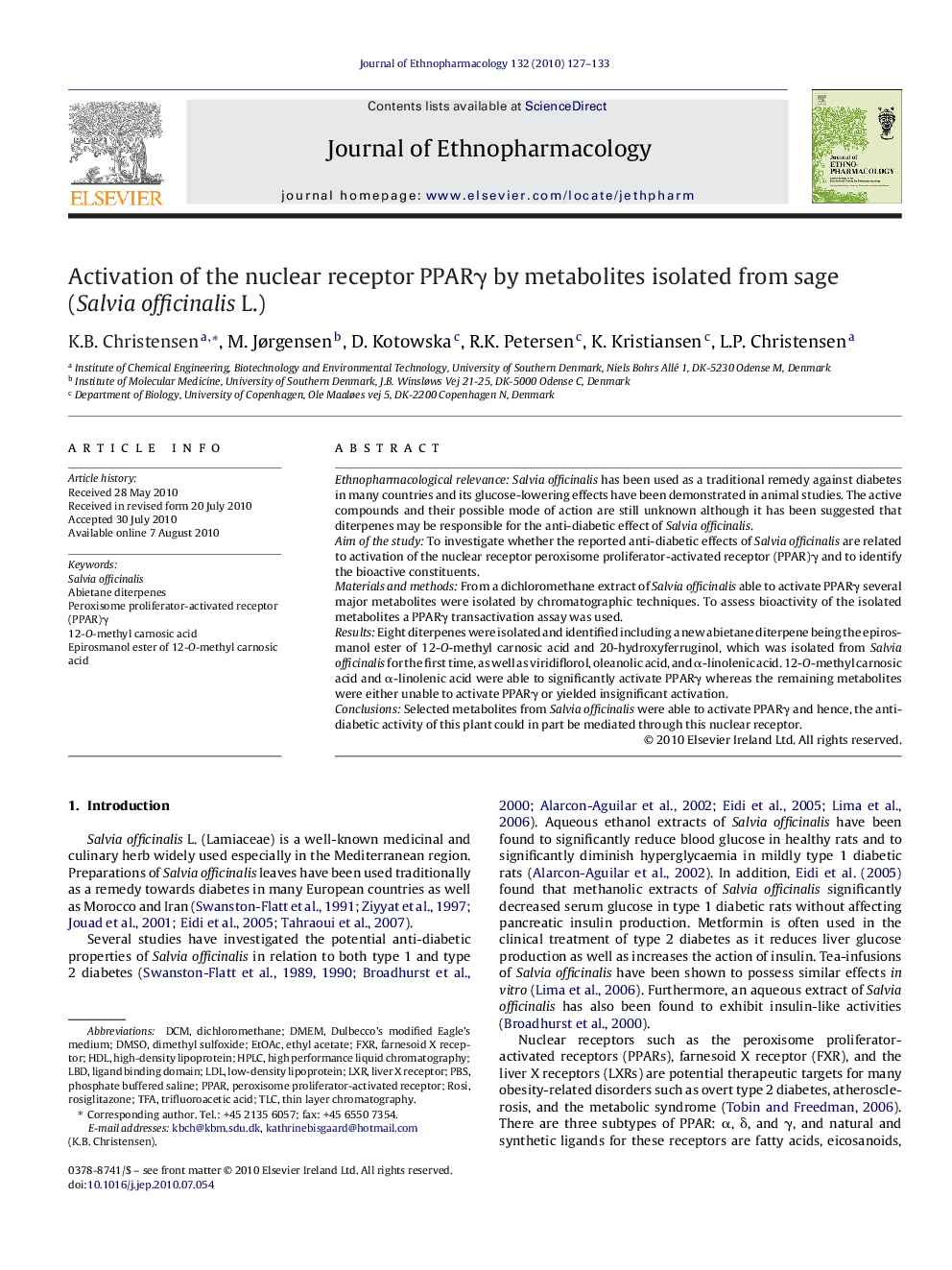| کد مقاله | کد نشریه | سال انتشار | مقاله انگلیسی | نسخه تمام متن |
|---|---|---|---|---|
| 2545657 | 1123990 | 2010 | 7 صفحه PDF | دانلود رایگان |
عنوان انگلیسی مقاله ISI
Activation of the nuclear receptor PPARγ by metabolites isolated from sage (Salvia officinalis L.)
دانلود مقاله + سفارش ترجمه
دانلود مقاله ISI انگلیسی
رایگان برای ایرانیان
کلمات کلیدی
PBSFXRSalvia officinalisLXRPPARTFATLCEtOAcHDLDCMLBDAbietane diterpenesDMEMDMSO - DMSOfarnesoid X receptor - Farnesoid X گیرندهhigh-density lipoprotein - HDL یا لیپوپروتئین با دانسیته بالا یا چگالی بالاDulbecco's modified Eagle's medium - Medal of Eagle اصلاح شده DulbeccoEthyl acetate - اتیل استاتTrifluoroacetic acid - اسید Trifluoroaceticligand binding domain - دامنه اتصال لیگاندDichloromethane - دیکلورمتانDimethyl sulfoxide - دیمتیل سولفواکسیدROSI - رزیrosiglitazone - روزیگلیتازونPhosphate buffered saline - فسفات بافر شورLow-density lipoprotein - لیپوپروتئین کم چگالی یا الدیال LDL - لیپوپروتئین کم چگالی(کلسترول بد)liver X receptor - کبد X گیرندهthin layer chromatography - کروماتوگرافی لایه نازکhigh performance liquid chromatography - کروماتوگرافی مایع با کارایی بالاHPLC - کروماتوگرافی مایعی کاراperoxisome proliferator-activated receptor - گیرنده فعال فعال پروکسیوم
موضوعات مرتبط
علوم پزشکی و سلامت
داروسازی، سم شناسی و علوم دارویی
داروشناسی
پیش نمایش صفحه اول مقاله

چکیده انگلیسی
Ethnopharmacological relevanceSalvia officinalis has been used as a traditional remedy against diabetes in many countries and its glucose-lowering effects have been demonstrated in animal studies. The active compounds and their possible mode of action are still unknown although it has been suggested that diterpenes may be responsible for the anti-diabetic effect of Salvia officinalis.Aim of the studyTo investigate whether the reported anti-diabetic effects of Salvia officinalis are related to activation of the nuclear receptor peroxisome proliferator-activated receptor (PPAR)γ and to identify the bioactive constituents.Materials and methodsFrom a dichloromethane extract of Salvia officinalis able to activate PPARγ several major metabolites were isolated by chromatographic techniques. To assess bioactivity of the isolated metabolites a PPARγ transactivation assay was used.ResultsEight diterpenes were isolated and identified including a new abietane diterpene being the epirosmanol ester of 12-O-methyl carnosic acid and 20-hydroxyferruginol, which was isolated from Salvia officinalis for the first time, as well as viridiflorol, oleanolic acid, and α-linolenic acid. 12-O-methyl carnosic acid and α-linolenic acid were able to significantly activate PPARγ whereas the remaining metabolites were either unable to activate PPARγ or yielded insignificant activation.ConclusionsSelected metabolites from Salvia officinalis were able to activate PPARγ and hence, the anti-diabetic activity of this plant could in part be mediated through this nuclear receptor.
ناشر
Database: Elsevier - ScienceDirect (ساینس دایرکت)
Journal: Journal of Ethnopharmacology - Volume 132, Issue 1, 28 October 2010, Pages 127-133
Journal: Journal of Ethnopharmacology - Volume 132, Issue 1, 28 October 2010, Pages 127-133
نویسندگان
K.B. Christensen, M. Jørgensen, D. Kotowska, R.K. Petersen, K. Kristiansen, L.P. Christensen,